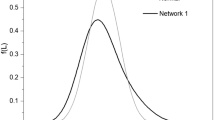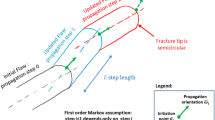Abstract
Rocks and other geomaterials are heterogeneous materials, with a well-recognized hierarchy of defects from micro-heterogeneities on the grain level to a large-scale network of cracks and layering structures. Their nature create a challenge for determining macroscopic properties, particularly for properties that are scale dependent, complicating both the property measurement and its appropriate application in modeling. This paper discusses the concept of a “representative volume”, which is commonly used in modeling microheterogeneous but statistically homogeneous material by an effective homogeneous continuum. The foundation of this concept is presented, along with its limitations in dealing with properties like strength and fracture toughness that exhibit a scale effect. This limitation is illustrated with a study of brittle fracture of a concrete where it is considered a model for statistically homogeneous rock. The study includes determining a scaling rule for the scale effect in fracture toughness, and shows that the fracture of brittle materials like rocks and concrete appears in the form of highly tortuous, stochastic paths. This reflects a complex interaction between a crack and pre-existing as well as newly formed micro-defects controlled by chance, and results in a large scatter of all fracture-related parameters. This behavior suggests a synthesis of fracture mechanics with probability and statistics, and so a brief exposition of statistical fracture mechanics (SFM) that addresses the statistical aspects of fracture is also presented. SFM is a formalism that combines fracture mechanics methods with probability theory and serves as the basis for an adequate modeling of brittle fracture.
















Similar content being viewed by others
References
Anderson TL (2005) Fracture mechanics: fundamentals and applications. CRC Press, Boca Raton
Bazant ZP, Planas J (1998) Fracture and size effect in concrete and other quasibrittle materials. CRC Press, Boca Raton
Borel E (1956) Probabilite’ et Certitude. Presses Universitaires De France, Paris
Bridgman PW (1912) Breaking tests under hydrostatic pressure and conditions of rupture. Phil Mag 24:63–80
Brook E, Franklin JA (1972) The point load strength test. Int J Rock Mech Min Sci 9:669–697
Calomino A (1992) Fracture behavior of ceramics under displacement control loading. NASA TM-105656, Cleveland, OH
Carpinteri A, Puzzi S (2009) The fractal-statistical approach to the size-scale effects on material strength and toughness. Prob Eng Mech 24:75–83
Chechulin VV (1963) Scale effect and statistical nature of strength of materials (in Russian). Metallurg Press, Moscow
Chudnovsky A (1973) Fracture of solid (in Russian). In: Kachanov LM (ed) Research in elasticity and plasticity, 3–43, Leningrad State University, St Petersburg
Chudnovsky A (1997) Modeling of brittle fracture based on the concept of crack trajectory ensemble. Eng Frac Mech 58(5–6):437–457
Chudnovsky A, Kunin B (1987) A probabilistic model of brittle crack formation. J Appl Phys 62(10):4124–4130
Chudnovsky A, Kunin B (1989) A probabilistic approach to crack instability. In: Salama K et al (eds) Advances in fracture research. Pergamon Press, New York, pp 23–35
Committee on Fracture Characterization and Fluid Flow, National Research Council (1996) Rock fractures and fluid flow: contemporary understanding and applications. National Academy Press, Washington, DC
Del Viso JR, Carmona JR, Ruiz G (2008) Shape and size effects on the compressive strength of high-strength concrete. Cem Concr Res 38:386–395
Fernandes JS, Appoloni CR, Fernandes CP (2012) Determination of the representative elementary volume for the study of sandstones and siltstones by X-Ray microtomography. Mater Res 15(4):662–670
Fisher RA, Tippett LHC (1928) Limiting forms of the frequency distribution of the largest and smallest member of a sample. Proc Camb Philos Soc 24:180–190
Gelfand IM, Jaglom AM (1960) Integration in functional spaces and its applications in quantum physics. J Math Phys 1(1):48–69
Gorelik M (1995) Experimental and analytical studies of crack initiation and arrest in hot pressed silicon nitride. Frac Mech 25:71–85
Gorelik M, Chudnovsky A (1993) Statistical fracture mechanics: basic concepts and numerical realization. Probab Mater (Tests, Models and Applications) 269:321–338
Griffith AA (1921) The phenomena of rupture and flow in solids. Philos Trans R Soc Lond, Ser A 221:163–198
Griffiths DV, Paiboon J, Huang J, Fenton GA (2012) Homogenization of geomaterials containing voids by random fields and finite elements. Int J Solids Struct 49:2006–2014
Gumbel EJ (1958) Statistics of extremes. Columbia University Press, New York
Hertzberg RW (2012) Deformation and fracture mechanics of engineering materials. Wiley, New York
Heuze FE (1980) Scale effect in determination of rock mass strength and deformability. J Rock Mech 12:167–192
Illman WA (2006) Strong field evidence of directional permeability scale effect in fractured rock. J Hydrol 319:227–236
Inglis CF (1913) Stresses in a plate due to presence of cracks and sharp corners. Trans R Inst Nav Archit 55:219–230
Issa MA (2000a) Size effects in concrete fracture: part I, experimental setup and observations. Int J Frac 102:1–24
Issa MA (2000b) Size effects in concrete fracture: part II, analysis of tests results. Int J Frac 102:25–42
Jasarevic H (2009) Observation, characterization and modeling of fracture initiation phenomenon. Dissertation, University of Illinois, Chicago
Kac M (1957) Probability and related topics in physical sciences. Interscience Publishers, London
Kevin RH (1999) Scale effects in strength-dominated collisions of rocky asteroids. Icarus 142:21–33
Koyama T, Jing L (2007) Effects of model scale and particle size on micro-mechanical properties and failure processes of rocks—A particle mechanics approach. Eng Anal with Bound Elem 31:458–472
Mull MA (1987) A probabilistic approach to the fracture toughness of composites. Philos Mag A 56(3):419–443
Rossi P, Wu X, Le Maou F, Belloc A (1994) Scale effect on concrete in tension. Mater Struct 27:437–444
Thuro K, Plinninger RJ, Zah S, Schutz S (2001) Scale effects in rock strength properties. In: Rock mechanics—a challenge for society. Proceedings of the ISRM Regional Symposium EUROROCK 2001, Finland, pp 169–180
Tuncay E, Hasancebi N (2009) The effect of length to diameter ratio of test specimens on the uniaxial compressive strength of rock. Bull Eng Geol Environ 68:491–497. doi:10.1007/s10064-009-0227-9
Ulusay R, Hudson JA (2007) Suggested methods for determining water content, porosity, density, absorption and related properties and swelling and slake-durability index properties. http://www.personal.psu.edu/szw138/Rock%20Mechanics%20Lab/Other%20ASTM/Water%20content,%20porosity,%20density,%20absorption%20and%20related%20properties%20and%20swelling%20and%20slake-urability%20index%20properties.pdf
Weibull W (1951) A statistical distribution function of wide applicability. J Appl Mech Trans 18(3):293–297
Yoshinaka R, Osada M, Park H, Sasaki T, Sasaki K (2008) Practical determination of mechanical design parameters of intact rock considering scale effect. Eng Geol 96:173–186
Zhang Q, Zhu H, Zhang L, Ding X (2011) Study of scale effect on intact rock strength using particle flow modeling. Int J Rock Mech Min Sci 48:1320–1328
Author information
Authors and Affiliations
Corresponding author
Rights and permissions
About this article
Cite this article
Zhang, H., Chudnovsky, A., Wong, G. et al. Statistical Aspects of Microheterogeneous Rock Fracture: Observations and Modeling. Rock Mech Rock Eng 46, 499–514 (2013). https://doi.org/10.1007/s00603-013-0379-6
Received:
Accepted:
Published:
Issue Date:
DOI: https://doi.org/10.1007/s00603-013-0379-6




